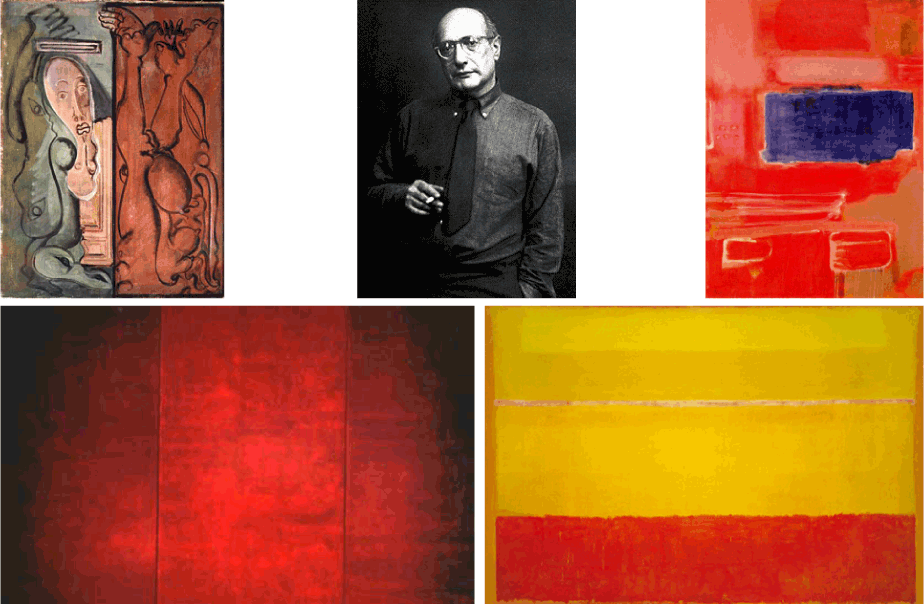The inspiration for our paintball teams: de Kooning Francis Pollock Rothko
Willem de Kooning
Although Willem de Kooning was born in Hollond in 1904, he moved to the United States in the 1920s. He became a key player in the New York school of art in the 1950s and a pioneer in Abstract Expressionism. As an action painter, he tried to capture a sense of energy and emotion in his work. In doing so, he alternated between abstract and figural painting. While much of his work resembles the total abstraction of painters like Jackson Pollock, his best pieces combine the chaos of expressionism with more traditional forms. As in "Woman I," the human figure is visible, but it is disintegrating into a chaotic blend of colors and textures. It was through paintings like these that de Kooning became a leader of the Abstract Expressionist movement. By blending traditional forms with a sense of ambiguity, he moved beyond the constraints of art history and opened the door for new methods of expression. What was his motivation for this experiment with Abstract Expressionism? As Willem de Kooning explained, "Ambiguity prevails in an art and in an age where nothing is certain but self-consciousness."

Sam Francis
Sam Francis was serving in the US Army Air Corps when he injured his spine during a plane crash. He took up painting in 1944 while recovering in the hospital. Francis moved to Paris in 1950 and studied under Leger. The friends he met, most of who were members of the Art Informel movement, influenced his style. He visited Japan several times and his thin drip technique is reminiscent of Japanese contemplative art. Francis returned to his home state, California, in 1961, eventually settling in Santa Monica. His work took on a Minimalist attitude upon his return to the States. He also produced murals, watercolors, lithographs, and some sculptures.

Jackson Pollock
"On the floor I am more at ease, I feel nearer, more a part of the painting, since this way I can walk around in it, work from the four sides and be literally `in' the painting." -- Jackson Pollock, 1947.
Jackson Pollock, the commanding figure of the Abstract Expressionist movement, began to study painting in 1929 at the Art Students' League, New York, under the Regionalist painter Thomas Hart Benton. During the 1930s he worked in the manner of the Regionalists, being influenced also by the Mexican muralist painters (Orozco, Rivera, Siqueiros) and by certain aspects of Surrealism. From 1938 to 1942 he worked for the Federal Art Project. By the mid 1940s he was painting in a completely abstract manner, and the `drip and splash' style for which he is best known emerged with some abruptness in 1947. Instead of using the traditional easel he affixed his canvas to the floor or the wall and poured and dripped his paint from a can; instead of using brushes he manipulated it with "sticks, trowels or knives" (to use his own words), sometimes obtaining a heavy impasto by an admixture of sand, broken glass or other foreign matter. This manner of Action painting, like the Surrealist theories of automatism, was supposed by artists and critics alike to result in a direct expression or revelation of the unconscious moods of the artist.
Pollock's name is also associated with the introduction of the all-over style of painting, which avoids any points of emphasis or identifiable parts within the whole canvas. Therefore it abandons the traditional idea of composition in terms of relations among parts. The design of his painting had no relation to the shape or size of the canvas. In the finished work the canvas was sometimes docked or trimmed to suit the image. All these characteristics were important for the new American painting which matured in the late 1940s and early 1950s.

Mark Rothko
Mark Rothko was a Russian-born U.S. painter. His family settled in Portland, Oregon in 1913, and he took up painting (largely self-taught) after moving to New York City in 1925. His early realistic style culminated in the Subway series (late 1930s). The semiabstract forms of his work in the early 1940s developed into a highly personal, contemplative form of Abstract Expressionism by 1948. Unlike many of his fellow Abstract Expressionists, Rothko never relied on such dramatic techniques as violent brush strokes or the dripping and splattering of paint. Instead, his virtually gestureless paintings achieved their effects by juxtaposing large areas of melting colours that seemingly float parallel to the picture plane in an indeterminate, atmospheric space. Rothko spent the rest of his life refining this basic style through continuous simplification. In 1965 – 66 he completed 14 immense canvases, whose sombre intensity reveals his deepening mysticism; they are now housed in a chapel in Houston, which was named the Rothko Chapel after his suicide.

Click here to view the creative and other collateral.
